
The Internet's Premier Classical Music Source
Related Links
- Xenakis Reviews
- Latest Reviews
- More Reviews
-
By Composer
-
Collections
DVD & Blu-ray
Books
Concert Reviews
Articles/Interviews
Software
Audio
Search Amazon
Recommended Links
Site News
 CD Review
CD Review
Iannis Xenakis
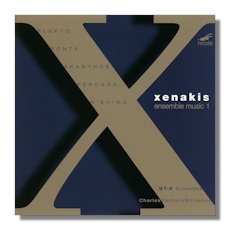
Xenakis Edition
Volume 1 - Ensemble Music 1
- Plektó (1993)
- Eonta (1962-64) 1,2
- Akanthos (1977) 1,3
- Rebonds (1987-89) 1,4
- N'Shima (1975) 1,5
1 Justin Rubin, piano
2 Susan May, soprano
3 Robert McEwan, percussion
4 Catherine Aks, voice
4 April Lindevold, voice
ST-X Ensemble/Charles Zachary Bornstein
Mode 53

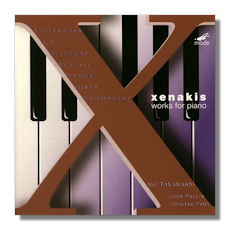
Volume 4 - Complete Works for Piano Solo
- Evryali (1973)
- Dikhthas (1979) 1
- Herma (1960-61)
- Palimpsest (1979) 2
- Six Chansons pour piano
- Ça sent le musc…
- J'avais un amour autrefois…
- Une perdrix descendait de la montagne…
- Trois moines crétois…
- Aujourdui le ciel est noir…
- Sousta, danse
- Mists (1980)
- A.r. (Hommage à Ravel) (1987)
Aki Takahashi, piano
1 Jane Peters, violin
2 The Society for New Music/Charles Peltz
Mode 80

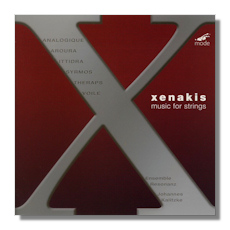
Volume 6 - Music for Strings
- Syrmos (1959) for 18 Strings
- Aroura (1971) for 12 Strings
- Voile (1995) for 20 Strings
- Theraps (1975-76) *
- Analogique A+B (1959) for 9 Strings & Tape
- Ittidra (1996)
* John Eckhardt, double bass
Ensemble Resonanz/Johannes Kalitzke
Mode 152

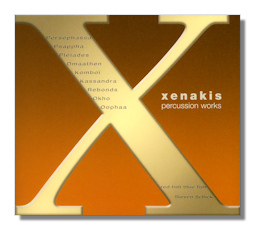
Volume 7 - Percussion Works
- Persephassa (1969) 1
- Psappha (1975) 2
- Dmaathen (1977) 3
- Pléîades (1978) 4
- Mélanges 5
- Claviers 6
- Métaux 6
- Peaux 6
- Komboî (1981) 7
- Kassandra (1987) 8
- Okho (1989) 9
- Oophaa (1989) 10
- Rebonds (1989) 11
1,4,9 Percussion Ensemble red fish blue fish
2,3,8,11 Steven Schick, percussion
3 Jacqueline Leclair, oboe
5 Gustavo Aguilar, Rob Esler, Ross Karre, Don Nichols, Morris Palter, Lisa Tolentino
6 Patti Cudd, Terry Longshore, Ivan Manzanilla, Brett Reed, David Shively, Vanessa Tomlinson
7 Aiyun Huang, percussion
7 Shannon Wettstein, harpsichord
8 Philip Larson, voice
9 Terry Longshore, Brett Reed & David Shively, djembes
10 John Mark Harris, harpsichord
Mode 171/73 3CDs (see note in text)

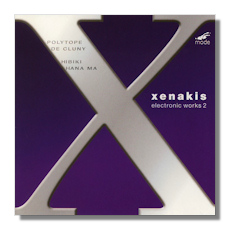
Volume 9 - Electronic Works 2
Electroacoustic Works for 8-Channel Tape
- Hibiki Hana Ma (1969-70)
- Polytope de Cluny (1972-74)
Gerard Pape, electroacoustic realisation
Mode 203
Also available on DVD Surround Sound:
Amazon
- UK
- Germany
- Canada
- France
- Japan
- ArkivMusic
- CD Universe
- JPC

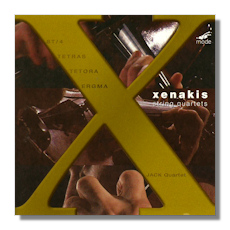
Volume 10 - Complete String Quartets
- Tetras (1983)
- Tetora (1990)
- ST4/1 (1956-62)
- Ergma (1994)
The JACK Quartet
Mode 209
Also available on DVD Surround Sound:
Amazon
- UK
- Germany
- Canada
- France
- Japan
- ArkivMusic
- CD Universe
- JPC

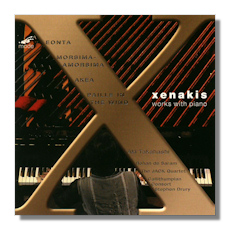
Volume 11 - Works with Piano
- Eonta for Piano, 2 Trumpets & 3 Trombones (1963) 1
- Morsima/Amorsima for Piano, Violin, Cello & Double Bass (1962) 1
- Akea For Piano & String Quartet (1986) 2
- Paille in the Wind for Piano & Cello (1992) 3
Aki Takahashi, piano
1 The Callithumpian Consort/Stephen Drury
2 JACK Quartet
3 Rohan de Saram, cello
Mode 217
Also available on DVD Surround Sound: Amazon - UK - Germany - Canada - France - Japan - ArkivMusic - CD Universe - JPC
Iannis Xenakis was born in 1922; it's hard to believe it's almost ten years since he died – in 2001. His life (and profession) as mathematician and architect are well-known. Ironically, his music less so. Here a representative selection of recent CDs from the specialist label, Mode, is examined in an attempt to expose the variety, depth, beauty and breadth of Xenakis' musical achievement. Particularly since there are otherwise very few reviews of his music on Classical Net. His is a special music full of an imagination, an energy and of a great deal of color that are both unpredictable and somewhat concealed by the emphasis usually given to his innovations in composing, production and other technical aspects of music-making. Specifically, Xenakis' application of mathematical models (notably certain aspects of set theory) and stochastic (randomly determined) processes to composition and performance, as well as his development of electronic music, have tended to put listeners off; the composer has acquired an aura of extreme difficulty, unapproachability and unnecessary abstraction. These are not deserved. It is hoped that this small survey will open new and enduring ways to appreciate Xenakis. Thanks to Mode for supporting Classical Net in this aim.
Plektó from 1993, Eonta (1962-64), Akanthos (1977), Rebonds (1987-89), and N'Shima (1975) make an excellent place to start. They come on the "Ensemble 1" CD, mode53. The music is as accessible in these six recordings as it is small-scale, concentrated and focused. The longest, Eonta ("Being"), lasts under 18 minutes. It's typical of Xenakis' way of using "batches", "bunches" or "clouds" of sound to identify and thus move forward the work's component sections. The unusual combination of piano, two trumpets and 3 (tenor) trombones explores relationships between timbre and scale. But that "exploration" – as always with Xenakis – is full of purpose. Music as music is just as important as sound as sound. Though if you're unfamiliar with the idiom, it has to be listened for. A relatively narrow tonal range is contrasted with emphasis on spatial change in the positioning of the brass on the (sound) stage. N'Shima ("Breath, spirit, soul – Hebrew"), from 1975, also uses prominent brass, and very effectively amplified cello, joined by small groups of vocalists – specified to be "peasant voices". Its broken, syllabic, at times gently staccato sounds are highly memorable and have advanced N'Shima to a place amongst Xenakis' most celebrated works. As with the other pieces on this CD, the commitment, energy and determination of the performers is virtually palpable. Their effort to respect the dynamics (climaxes, sostenuti and cycling tempi) throughout what is a very demanding piece is very compelling: in this case the dozen and a half-strong ST-X Ensemble reveal all the subtleties of the music.
Akanthos appears on first hearing to be much gentler and restrained. Yet one of Xenakis' characteristics is that sonic restraint may imply even greater tautness of conception and structure. Tellingly, Akanthos means "thorn". Furthermore, this is a piece which strongly exhibits Xenakis' concern to bring the past (it has been called "prehistoric") into his music – in this case by invoking (and thus, ultimately, conveying) fear, ritual and symbolism… snake-like glissandi; screams (invented phonemes) for instance. This is not program music, of course. Nor anything so mechanistic as it sounds. Again, the performers have thoroughly absorbed and understood the composer's intention and dedication to refining the relationship between conception and execution. Rebonds is a later work and just as full of life. But using percussion only, the remarkable thing is the sense of pitch which the soloist (Robert McEwan) achieves. Finally Plektó ("braids") further extends the range of Xenakis: counterpoint is emphasized over texture. Again, this is redolent of extra-musical reference – in this case the Chorus of Greek theater. As is the case with all the CDs considered here, the acoustic and the recording itself are excellent in providing a sense of space, immediacy and balance between instruments and overall impact.
The Xenakis Edition Volume 4 (Mode 80) contains the complete works for piano. Aki Takahashi is the pianist throughout – joined by Jane Peters, violin, in Dikhthas and The Society for New Music conducted by Charles Peltz in Palimpsest. There are seven works here – written between 1960 and 1987. Xenakis' principle that music is not a language but lives in the realm of numbers, and numbers as known to the Ancient (Xenakis considered himself an "ancient" Greek exiled in the 20th century) and early Medieval Greeks at that, is perhaps most clearly demonstrated in his solo piano music. It's a compelling theory, and one which repays study. Indeed, it was Xenakis' music that spurred pianist Aki Takahashi to devote her career to performing contemporary music. Her playing of all those on this CD is exemplary; it illustrates what's best in performances of this corner of Xenakis' output. There are clarity, excitement, depth and great perspective – for this is demanding repertoire.
Evryali dates from 1973; it explores Xenakis' mathematical "arborescent" procedure, whereby branches of ever smaller length originate in a common source. The essence of the piece and the application of the highly visual arborescence to it explore continuity on an instrument each of whose notes is of short (certainly finite) duration. At under ten minutes, to do this successfully is not easy. The need is to guide our attention between clusters of sound, though sufficiently close tonally almost to suggest – at times – melodic homogeneity. To convey the composer's intention is technically quite a feat. Takahashi does admirably, particularly since the momentum of the piece is interrupted frequently as the piece's internal "movements" come and go: this is no minimalist slur. Dikhthas (1979) has a strong conceptual thrust as well: in this case to examine the conflict, contradiction certainly, implicit in pitching piano with another instrument – here the violin. The word means "dual". But it could refer just as easily to "duel". Again, exposure (exploitation, almost) of the very nature of the sound of each instrument is paramount: the piano is percussive, polyrhythmic and dense. The violin is rich in portamenti, glides, gradualist playing and glissandi. The danger is that the players concentrate on these sonic qualities to the exclusion of what is musical. It's a danger they avoid from first to last – largely by intelligent use of tempi and an awareness of the architecture of the piece.
Herma from 1960-61 is Xenakis' first exploration of set theory. Indeed, the mathematics behind the piece, which means "bond", "embryo" or "foundation", are intricate. Herma focuses on the structural relationship between pitches and the order and combinations in which they exist. Once again, the idea is far more off-putting, perhaps, than the virtuosic, beautiful and compelling musical result. In fact, even the stochastic elements – especially when taken with the contrasts, variety and play between densities and timbres – should cease to intimidate after a listening or two. It will become clear that there is much with which to gain a toehold, then to become warmly familiar in this music. As its name suggests, Palimpsest (1979) is concerned with successive layers of music; at the start they are distinguishable, one from the other. As the twelve-and-a-half-minute work progresses, though, the density grows: one mass of sound results. Not the first time this had been attempted. But surely as successful before or since. A remarkable accomplishment by the percussionists, wind and strings. And of Takahashi to keep her head above water. The non-repeating nature of arborescence is in evidence here too. Though there is precious little microtonality alone in this one work on this CD
Typically for Xenakis, Mists (1980) has little or nothing to do with physical imagery. Rather, perhaps, the perceived uncertainty of the listener as scales played in varying tempi are slowly but relentlessly added to the sonic mass. Then again, the mists might be the process by which pitch-time space is explored using Sieve theory (a branch of Set theory) and rotational procedures mean that the sound textures provide constant stimulus and enjoyment. For, Yes, this is very enjoyable music. Alive, vital and searching. Yet with its implied answers never drawn away just as you're about to reach them. To the performers it seems to come very naturally to take us on that search. A.r. (Homage à Ravel) examines the relationships (implicit and more candid) between chains of sound and chords. Takahashi's approach is to work her way through the piece as effortlessly and suavely as if it were Schubert or even Mozart! The Six Chansons pour piano date from the early 1950s and reflect in part the influence on Xenakis of Milhaud and Messiaen, with whom he was studying. This is their first recording for they were only published in 2000. It's a worthy one – all the more so for taking the music at face value and not trying to read into it or color it with what we know about how Xenakis' music has evolved so significantly.
Equally accessible, despite what anyone as yet unfamiliar with Xenakis' world might have expected, is his percussion music. It's contained on three CDs which are cataloged as "mode170/73" and have labels, "mode171", "mode 172R" and "mode173". This collection in the Xenakis Edition is distributed across these three CDs, though, to give contrast on any one CD between style and instrumental forces; although the dates of the works on the CDs are roughly chronological – from 1969 to 1989. The two works for solo percussion are Psappha, from 1975, on mode171 and the two Rebonds (B/A) written in 1989 on mode173. The four pieces for percussion and instruments are Dmaathen, from 1977, on mode171; Komboî (1981) on mode172R; Kassandra (1987) on mode173; and Oophaa (1989) on mode173. The three works for percussion ensemble are Persephassa from 1969 on mode171; the four Pléîades (1978) on mode172R; and Okho (1989) on mode173. There is huge variety in and among these works. And, given the scope of Xenakis' musical and wider artistic intentions across the nine pieces, which last from nine to nearly thirty minutes, the playing of several soloists and groups is remarkably accomplished.
Perhaps the reason why this music sounds so familiar to us is that it was Xenakis who effectively pioneered tuned percussion with Persephassa. This is a truly startling and indeed truly beautiful work. It's closer to Varèse and even the percussive sonorities of Messiaen than later twentieth century works, which elevated rhythm to its own art form. Xenakis' conception was more subtle. More in the traditions of Henry Cowell and John Cage. This is in keeping with the positioning of Xenakis as a figure of contrasts, contradictions even. To have mapped the certainties of serialism onto percussive techniques was not Xenakis' way. He was happier with greater nuances and elusiveness. Xenakis was also ahead of his time in that Pléîades, for example, was using techniques borrowed from Eastern (particularly Gamelan) traditions – at least in their timbres and the complexity of their rhythms – when practically only Colin McPhee had done so before.
The percussion ensemble, red fish blue fish (Patti Cudd, Aiyun Huang, Terry Longshore, Brett Reed, David Shively, Vanessa Tomlinson), is resident at the University of California, San Diego. It consists of six soloists who also perform individually in several of these works. They are joined by nine others with "pure" percussion (though an ensemble of instruments) and the harpsichords of Shannon Wettstein and John Mark Harris in Komboî and Oophaa. These players are all completely in accord with what Xenakis wanted; their playing is vibrant, accurate and inspired. Really to enter into Xenakis' unique creativity using percussion it's necessary to understand the role of ritual, the role of antiphony, and of course of color (wood, metal instruments; the historico-liturgical origins of the instruments; the sonorities which result from chance as well as planned combinations). While you wouldn't expect such players as those on these recordings to lack the technique and imagination to cope well with all of these aspects, the relative weights necessary to emphasize what Xenakis wanted require subtlety and discernment are here in abundance in these performances. There is no letting up, for example, when complexity and frenetic tempi and texture give way to unity and simplicity. They're accorded just as much care and focus. The exact nature of the color of the West African drums, djembes in Okho, is as important as the relentlessness of the multi-voicing of Psappha. The players use the necessary contrasts and relative weights to bring these out. Similarly, to have successfully set the oboe against percussion in Dmaathen is a real achievement: the contrast lives.
Xenakis' electronic music is central to his output. An appreciation of it is thus crucial in understanding the composer's work. Volume 9 of the Xenakis Edition (Electronic Works 2), mode203, contains two works, which the CD label instructs should be played as loud as possible: Hibiki Hana Ma dates from 1969/70; and Polytope de Cluny (1972-74). Both are electroacoustic works for eight channel tape expertly realized here by Gerard Pape. In fact, Xenakis believed that this music should impart a physical experience, that you should literally feel its vibrations – in your body, let alone your ears!
Hibiki Hana Ma is just such a piece. It begins with barrages of low frequency sound articulated with such a force and intensity that the air pressure is in fact physically altered around you. The commission for the piece, from Tōru Takemitsu for the Osaka World's Fair in 1970, anticipated that it be performed in an acoustic which was then state-of-the-art, with a total of 700 loudspeakers disposed under, above and surrounding the pavilion's amphitheater. Space – conceived electronically – quickly (one suspects) took over from the original orchestral idea. Light and visual effects were added. Tempi, volume and timbre were all important; the piece that resulted lasts nearly 18 minutes and makes a marvelous fusion of sonic elements that is at once highly musical and also pre-eminently physical, both in the sense of clear feeling and mathematical mechanics. This exploration of mathematically opposite entities continues to the very end in its unexpected abruptness. Indeed, Hibiki Hana Ma is a fitting titleÉ "Reverberation - Flower - Interval". It's a piece of great originality, forward momentum and compelling presence.
It was while in Japan that Xenakis first encountered lasers and began to develop a sense of how they too could be used in composition. These, the particularities of space again and the blends that can result from an amalgam of media (in this case theatrical spectacle and sound), drive Polytope de Cluny. The Roman baths at Cluny inspired an elaborate polytope> (a multimedia work as aware as much of the relationship between sound and space as of either entity on its own) that seems to require an even louder, thunderous volume of sound. Not unlike being in the middle of a static (!) tornado. Computers were needed for the initial installation of the Polytope de Cluny to handle a total of over 43 million commands. This seems to be a more honest (and much more successful) application of technology and indeed pure science with music than merely overlaying sound with pulsing lights or spinning beams. It set a new landmark at its time. And was so successful that Xenakis was invited back to the Shiraz Festival, which saw the piece's first incarnation, the following year. In the case of both these pieces, Brian Brandt and Gerard Pape have made a stunning new stereo and 5.1 realization mastered digitally to 24 bits.
Mode 209 contains Xenakis' four string quartets – not a medium usually associated with the composer. Yet to draw too sharp a distinction between the worlds of huge polyrhythmic orchestral scores and the intimacy and focus of the string quartet is to misunderstand the qualities of intensity and concentration so central to Xenakis' work. From the first notes and phrases of Tetras written in 1983 suggest most powerfully yet again the extent to which the composer (like perhaps only Bartók and perhaps Britten in the twentieth century) was so deftly and deliberately able to direct the music into itself, the extent, too, to which its development matures organically from what comes before – rather than evolve out of any extra-musical topoi or ideas. It constantly folds into itself, thematically, harmonically, melodically, and even in terms of tempi. Add to this the fact that strings as a family at rarely far from Xenakis' orchestral heart. As with all the composer's music except the electronic (and arguably even here) he works with the inherent, essential sound of the instruments, elevates its unique characteristics and builds much out of little, like an inverted cone from the world of architecture, in which, of course, Xenakis was also so at home. Indeed that ST-4/1, Xenakis' first work in the medium, should date from the start of his career (1956-62) is evidence of his commitment to the form.
Xenakis effectively invented new string techniques such as the glissandi evident in these works (and Tetora (1990) in particular) where the sounds merge as the fingers are moved up and down the fingerboard. This agglomeration of sounds then itself becomes a building block with which to move towards entirely new composite sound experiences. And by suppressing expected vibrato Xenakis gently explored the relationship between tempo and rhythm with pitch also in radially new ways. Listen for these – and, other, groundbreaking – techniques in the playing of the JACK Quartet (Christopher Otto and Ari Streisfeld, violins, John Pickford Richards, viola, Kevin McFarland, cello), whose commitment to the innovation of the music is matched only by their unselfconsciousness in its intricacies, coupled with superb technical command of the three longer (at 13, 13½ and 17½ minutes) and the shorter (Ergma, just over 8 minutes) pieces. Note that ST-4/1 as heard here is in fact a transcription for string quartet of ST/10 and also explores stochastic techniques.
The arrangement on this CD of the four pieces is instructive: while it hints at the extent to which the composition of Xenakis' string quartets was spread out over his career, it also highlights the huge and rich variety between them. Ergma, for example, the last, seems to use sounds and motifs from the preceding three. It's more dissonant than the others and seems to return to a more basic, sparse style having, perhaps, the concerns of a composer reaching the end of his musical life. In fact, it is a little tempting to hear the hint of sentiment in the final strident bars of Ergma suggesting an awareness on the players', if not the composer's part, of the finite span of both music and life.
The JACK quartet never needs to indulge either themselves or the music. Their playing is forthright, crisp and full of weight without ever sounding coarse or abrupt. Worthy followers of the Arditti (for whom much of this repertoire was originally written and who also have recordings of their own, on Naîve 40016) tradition indeed.
Volume 11 in the Mode Xenakis Edition (Mode 217) contains four works with piano (the effervescent Aki Takahashi again), including another version of Eonta (1963) for piano, two trumpets and three trombones (members of the Callithumpian Consort). The performance illustrates nicely the essence of Xenakis' approach to instrumentation – as does, particularly, Akea (1986) as well: these scarcely set out to be virtuoso pieces in the way that even other composers of Xenakis' generation conceived and scored the resultant musical texture. In the case of the latter, the JACK quartet plays with Takahashi to explore the kinds of contribution that the piano (and "accompanying" instruments) can make to the music with the latter's own thematic identities, development and architecture.
The piano is not "incidental" in these pieces. Nor exactly "illustrative". Still less a vehicle for compositional principles. Rather, it's there at once both to articulate and exemplify, or typify, how the music works. At the same time, it's to be played as a key participant which almost compensates in stylistic certainty and decidedness for the (predetermined) set theory which Xenakis had begin to explore when Eonta was being written. For this reason, the acoustic and structural balance achieved by performers has to be informed by an intimate knowledge of the work(s) – in the ways in which it is in, say, Boulez', or Elliott Carter's music involving (otherwise) "solo" instruments. And these players understand this issue excellently. There is no hint of being over emphatic in their attack, nor reticent to expose the ritardandi, accelerandi, diminuendo and crescendi as they occur – so effectively, for example, at the end of the fourth and final piece, the beautiful Paille in the Wind (1992) [tr.4] with Rohan de Saram (cello) playing exquisitely.
Morsima/Amorsima (1962) is for piano, violin, cello and double bass; Akea (1986) for piano and string quartet again. The former is based almost completely on indeterminacy, using Xenakis' own software, "ST" (see above, ST-4/1, in the string quartet volume): durations, timbres, pitches, dynamics are all decided by chance. There are 17 sequences which can have from one to 53 bars. Akea is built as much upon mathematics… in this case on sieve theory with two complementary scales. Their intervals operate in a periodic way such that notes at the octave do not repeat. Scales as scales are entities in the music: they have as much as a life and role communicating color, sonority and melody as do the conventional relationships between instruments and their textures and ranges in earlier string ensemble compositions. The musicians here have to work with a different paradigm and do so very convincingly. Their achievement is all the greater when you recognize the great variety in textural effects… chords, clusters, changes in dynamic and so on. These are performances to marvel at.
Volume 6 of the Xenakis Edition (Music for Strings) is one of the most satisfying: Xenakis' affinity with strings is once more prominent and followed to its limits. For newcomers to the composer, the six works contained on mode152 are amongst the most accessible and attractive. Their sound world is rich, varied, clean and resonant. Ensemble Resonanz is conducted by Johannes Kalitzke, with John Eckhardt (double bass soloist) in Theraps. Xenakis is ever the experimenter, pioneer and innovator in these beautiful works, which were composed throughout his career. His tone and reach to communicate are striking from start to finish. The longest work (Theraps) lasts under 14 minutes. It was written between 1975 and 1976 and reveals an interesting and so far unmentioned characteristic of the composer: it was written for and dedicated to Fernando Grillo. In that successful playing of the piece (which explores new and exciting tones, timbres and registers of the (often virtually neglected) instrument) it's necessary for the performer to control their nerves, their sensibilities, as much as their muscles. Hence Xenakis' belief that a performer must be as much in control of themself as of their instrument. Theraps is an extraordinary piece – particularly in terms of the colors it evokes, almost without your realizing how Xenakis can possibly have achieved such depth and penetration. For sure, there are his signature glissandi and the work is aggressively microtonal. But its overall impact seems to come from deep inside, rather than from any superficial "effects". A highlight of this area of Xenakis' output and played to perfection by Eckhardt.
Syrmos is for 18 strings and dates from 1959. It too makes use of glissandi, clusters, dissonant statements and overlapping complex rhythmic patterns. It was works like this which garnered Xenakis the reputation of "difficult", "extremely unconventional" and even "violent" in the 1950s and after. Listening to it now, Syrmos comes across not as "tame" but stimulating, well-conceived and still exploratory. The challenges seem smaller – particularly in the hands of the expert musicians of Ensemble Resonanz. Aroura (1971) is for 12 strings. It is a summative and decisive work in the Xenakis canon in that it attempted to define the relationship between art and science – or, specifically, technology: although sounding neither mechanical nor mechanistic, it was conceived and developed on a system which later evolved into the UPIC synthesizer. Voile (1995) for 20 strings and Ittidra for sextet (1996) hint at the directions which Xenakis would have taken had he lived longer; certainly the concerns he was working with of the relationship between time, space and sound in his later years. They're the shortest pieces on this CD and have once more the compactness and sense of focus and concentration at which Xenakis is so accomplished without his ever laboring the point or making the steps he takes to arrive at them self-conscious or over intense. Again, the Ensemble seems able to have the music simply and effortlessly flow from their strings both as though encountering it for the first time, and as though it were the simplest, most linear music possible.
Analogique A+B is also an early work – from 1959 – and is for nine strings with tape. Typically of Xenakis, the tape passages appear both as "interludes" and as integral to the conception of the work, yet do not dominate it. Equally typically, that conception is abstract… the generation of a sine wave onto which acoustic material is superimposed. Nor is it a particularly austere sound. In fact, the piece illustrates a theme which applies to much of Xenakis' string music: that the sonorities of strings (albeit in this case with tape) are so basic to his conception of the way sound works that – in common with all the music on this (and Volume 10) CD – that they have a naturalness, a spontaneity and happy commonality with the very act of listening that cannot help but work very effectively. Again, it is to the players' credit that such a set of music is so successfully performed.
It's remarkable, pleasing, and highly gratifying that this music thus proves its enduring value and appeal after 40 years. It sounds not a bit dated, forced or stuck in its time. It's a tribute both to Xenakis and his conception and the team at Mode that the very essence of what the composer was aiming for, his commentary on the space-time continuum and place in achieving it and the profundity of his vision so original and full of life in what, on paper, could sound artificial, ephemeral and gimmicky. This is a volume in the Xenakis Edition (available as CD and DVD) which encapsulates and sums up much of what makes Xenakis such a pivotal figure.
One of the criteria for success of an Edition like this one from Mode is the extent to which the variety of performers both pursue their own visions and respect a common standard. In this case, the success is beyond doubt. And if a single reason explains that, it's that everyone involved seems to have approached Xenakis' music as beautiful, meaningful and delightful – in the most sensible and profound sense of that word. Although they have not, presumably, set out to "sell" wary listeners on how accessible Xenakis actually is, they (and the project) have surely won many converts. Not by hiding or downplaying such complexities as the composer's adherence to mathematics in music (not mathematics as music). But by embracing them, proving they work; and offering the listener hour after hour of stimulating and substantial music.
By and large the booklets that come with these Mode CDs are clear, helpful and well-written. Certainly always helpful. Although they contain inaccuracies (cadare, not "cadere" is Latin, not Greek, mode53, third page), they provide useful commentaries on Xenakis' importance and the essences of his music. This is, in summary, an important and excellently-executed project. Mode is to be congratulated. These recordings are all first rate. Whatever your experience of Xenakis, they offer some of the best that's available. Recommended completely.
Copyright © 2010 by Mark Sealey.





















